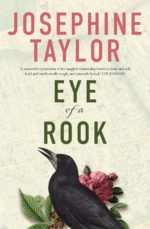Jessica Checkland shares her thoughts on the Great Big Book Club’s historical fiction panel featuring Josephine Taylor

I always love listening in to Josephine Taylor sharing her abundance of knowledge with enthusiasm and candour. I recently watched her chat to Fremantle Press publisher Georgia Richter on ‘Writing for History’ at the Great Big Book Club. The two spoke about vulvodynia, the central topic of Josephine’s novel, Eye of a Rook, history’s shunning of invisible illnesses, and the power of fiction in bringing these illnesses to the foreground.
Vulvodynia
After being diagnosed with the condition in 2000, Josephine’s personal experience with vulvodynia determined the course of her career. After completing a prize-winning PhD thesis, she began Eye of a Rook to ‘write something to help other women suffering’. While writing her novel, Josephine described how she ‘began to develop more agency’. Dealing with chronic illness, Josephine learned to shift her perspective from ‘looking back and asking, “Why is this happening to me?” to asking, “Where am I going with this?”’ She said, ‘writing creatively shifted my pain and gave it purpose’.
Shunning Invisible Illnesses
The novel shifts between contemporary Australia and nineteenth-century England and tells the story of two women, Alice and Emily, who each experience debilitating chronic pain. It is a book about the relationship of pain both to the body and to creativity. It is a very familiar story about women’s agency in a medical world where the pain of women is discounted or invisible. Josephine said she set Alice’s narrative in the recent past to show the similarities between Alice’s experiences and those of Emily in the nineteenth century, highlighting the lack of discourse on the condition throughout history and the patriarchal attitudes that continue to shame and silence women. Simply, she wanted to show what has and hasn’t changed.
Georgia asked Josephine about her construction of the male characters and how they upset the stereotypes of men in their time, with Emily’s husband, Arthur, being more sympathetic to Emily’s pain, whereas Alice’s husband, Duncan, is more conservative. Josephine said, ‘It doesn’t matter when we live – whether in the nineteenth century or today, we’re all just people. The focus is not on the timeline; it is on pain and how it affects the individual and those around them. Pain is pain, no matter when it happens.’
The Power of Fiction
The pair concluded the panel with a discussion on the power of fiction compared to, for example, a report in bringing these illnesses to the foreground. Both agreed that although a statistic is awful to read, the characters in a novel make it personal and we can therefore become more sympathetic to those who are suffering. Josephine said she didn’t want her characters to be just cardboard cut-outs. ‘I wanted you to care about them and understand their pain. I wanted you to understand the person, not just the percentage.’ As Georgia eloquently summed up, ‘fiction brings real life to bear.’
Eye of a Rook by Josephine Taylor is available in all good bookstores and online.



